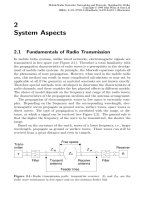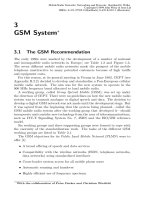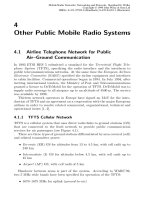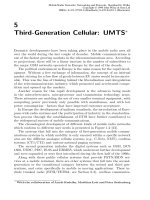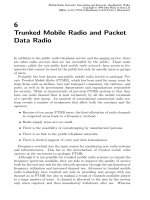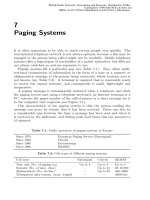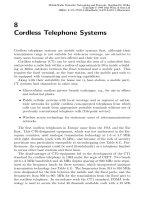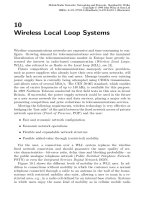Tài liệu Điện thoại di động băng thông rộng không dây P11 doc
Bạn đang xem bản rút gọn của tài liệu. Xem và tải ngay bản đầy đủ của tài liệu tại đây (212.05 KB, 4 trang )
6
Conclusions
The number of subscribers for mobile communications has increased much faster than
predicted, particularly for terrestrial use. In the year 2000 the number of mobile subscribers
was higher than 400 million worldwide and for the year 2010 more than 1700 million mobile
subscribers are anticipated.
The majority of traffic is changing from speech-oriented communications to multimedia
communications. It is also generally expected that due to the dominating role of mobile
wireless access, the number of portable handsets will exceed the number of PCs connected
to the Internet. Therefore, mobile terminals will be the major person-machine interface in the
future instead of the PC. Due to the dominating role of IP-based data traffic in the future the
networks and systems have to be designed for economic packet data transfer. The expected
new data services are highly bandwidth consuming. This results in higher data rate require-
ments for future systems.
The major step from the second generation to 3Gwireless and Beyond was the ability to
support advanced and wideband multimedia services, including email, file transfers, and
distribution services like radio, TV and software provisioning (e.g. software download).
These multimedia services can be symmetrical and asymmetrical services, real-time and
non real-time services. External market studies have predicted that in Europe in the year
2010 more than 90 million mobile subscribers will use mobile multimedia services and will
generate about 60% of the traffic in terms of transmitted bits. Only in China, the Delson
Group predicted that there will be 300 million mobile phones in China by year 2008, and over
100 million for multimedia applications.
In 3Gwireless the combination and convergence of the different worlds Information Tech-
nology (IT) industry, media industry and telecommunications will integrate communication
with IT. As a result, mobile communications together with IT will penetrate into various
fields of the society.
In future 4G mobile communications, two economically contradictive demands will arise;
ubiquity and diversity. Open, global and ubiquitous communications make people free from
spatial and temporal constraints. Versatile communication systems will also be required to
realise customised services based on diverse individual needs. The flexibility of mobile IT
can satisfy these demands simultaneously. Therefore, mobile IT can be seen to play a key
fundamental role in the 21
st
century.
The user expectations are increasing with regard to a large variety of services and applica-
tions with different degrees of quality of service (QoS), which is related to delay, data rate
and bit error requirements. Therefore, seamless services and applications via different access
Broadband Wireless Mobile: 3G and Beyond. Edited by Willie W. Lu
Copyright
2002 John Wiley & Sons, Ltd.
ISBN: 0-471-48661-2
systems and technologies that maximise the use of available spectrum will be the driving
forces for future developments.
In addition, many types of objects as well as people will have network functions and will
communicate with each other through networks. Therefore, different communication rela-
tionships such as person-to-person, machine-to-machine and mainly machine-to-person and
vice versa, will determine mobile and wireless communications in the future.
Given the increasing demand for flexibility and individuality in society, the meaning for
the end-user might be assessed. Potentially, the value would be in the diversity of mobile
applications, hidden from the complexity of the underlying communications schemes. This
complexity would be absorbed into an intelligent personality management mechanism, which
would learn and understand the needs of the user, and control the behaviour of their reconfi-
gurable terminals accordingly in terms of application behaviour and access to future support
services.
The trends from a service perspective include integration of services and convergence of
service delivery mechanisms. In particular, three pillars (triple-C or CCC, since each pillar
starts with the letter ‘C’) can characterise from a service perspective these trends of integra-
tion of services and convergence of service delivery mechanisms:
† Connectivity (provision of a pipe, including intelligence in the network and the terminal).
† Content (information, including push-pull).
† Commerce (transactions).
These trends will result in new service delivery dynamics and a new paradigm in tele-
communications where value added services such as those which are location-dependent will
provide enormous benefits to both the end users and the service providers.
The high level vision of the future development of 3Gwireless and beyond is considered to
be as follows:
† Future development of 3Gwireless. The vision for the future development of 3Gwireless is
that there will be a steady and continuous evolution. For example the current capabilities
of some of the terrestrial radio interfaces are already being extended towards 10 Mb/s and
it is anticipated that these will be extended even further over the next decade. The vision
for the future development of 3Gwireless is to raise the down-stream transmission speed
(from the base station to a terminal) to about 30 Mb/s by around the year 2005.
† Future development of 3Gwireless in relation to future development of other radio
systems. In conjunction with the future development of 3Gwireless there may be an
interrelationship with other radio systems, for example wireless LANs, digital video
broadcast, etc.
For systems beyond 3Gwireless, there may be a requirement for a new complementary
wireless access technology for the terrestrial component, sometime after the year 2010. This
will complement the future development of 3Gwireless and future development of other radio
systems. Present digital cellular systems have evolved by adding more and more system
capabilities and enhancements to make them resemble the capabilities of 3Gwireless systems.
It is anticipated that with 3Gwireless there will also be a continuum of enhancements that may
render those systems practically indistinguishable from systems beyond 3Gwireless, indeed,
the user should see a continuous increase in capability. The vision for a potential new radio
Broadband Wireless Mobile: 3G and Beyond358
interface is to support up to 50–100 Mb/s in the mobile environment and up to 1 Gb/s in the
stationary environment in the down-stream transmission by around the year 2010.
In the future wireless service provision will be characterised by global mobile access
(terminal and personal mobility), high quality of services (full coverage, intelligible, no
drop and no lower call blocking and latency), and easy and simple access to multimedia
services for voice, data, message, video, world-wide web, GPS, etc. via one user terminal.
End-to-end secured services will be fully co-ordinated, via access control, authentication
use of biometric sensors and/or smart card and mutual authentication, data integrity and
encryption with no intermediate gateway(s) for decryption/re-encryption. User-added
encryption features for higher levels of security will be part of the system.
The vision for the future development of 3Gwireless is that there will be a steady and
continuous evolution over the next 10 years. Beyond this timeframe, for systems beyond
3Gwireless, there may be a requirement for a new wireless access technology for the terres-
trial component, sometime after 2010.
It is expected that the further development of 3Gwireless will increase its capabilities for a
considerable period. In the longer term, these capabilities will be complemented by the
introduction of systems beyond 3Gwireless.
Considering how second-generation systems have evolved by adding more and more
system capabilities and enhancements to make them resemble the capabilities of 3Gwireless
systems, it is possible that with third-generation systems there may be a continuum of
enhancements that will render those systems practically indistinguishable from future genera-
tion systems. Indeed, it is expected that it will be more difficult to identify distinct generation
gaps and such a distinction may only be possible by looking back at some point in the future.
The vision from the user perspective can be implemented by integration of these different
evolving and emerging access technologies in a common flexible and expandable platform to
provide a multiplicity of possibilities for current and future services and applications to users
in a single terminal. Systems beyond third-generation will mainly be characterised by a
horizontal communication model, where different access technologies as cellular, cordless,
WLAN type systems, short range connectivity and wired systems will be combined on a
common platform to complement each other in an optimum way for different service require-
ments and radio environments which in my words is called ‘Converged Broadband Wire-
less Core’.
Figure 6.1 shows the capabilities of 3Gwireless and systems beyond. These access systems
will be connected to a common, flexible and seamless core network. The mobility manage-
ment will be part of a new Media Access System as interface between the core network and
the particular access technology to connect a user via a single number for different access
systems to the network. This will correspond to a generalised access network. Global roaming
for all access technologies is required. The interworking between these different access
systems in terms of horizontal and vertical handover and seamless services with service
negotiation including mobility, security and QoS will be a key requirement, which will be
handled in the newly developed Media Access System and the core network.
In addition to the above technologies, the critical issues for the mobile terminals are:
† new power technology – to empower the intelligent mobile applications;
† new transceiver technology – improve the receiving and transmitting performance for the
future 4G mobile systems;
Conclusions 359
† open CAI (Common Air Interface) core interfaces – to support the re-configurable and
software radio architecture.
Chip technology is always the key point in the next generation mobile communications.
The technology advancement in DRAM, DSP, Processor as well as RF will definitely drive
this 4G mobile wave, and eventually deliver this future-proof new generation broadband
wireless mobile communication system.
Life is Beautiful – powered by 3Gwireless and beyond!
Acknowledgements
Thanks are given to the ITU-R WP8F team for providing the source of beyond IMT-2000
systems. Special thanks go to Fabio Leite for his leadership in this IMT-2000 mission and his
continued supports in our various 3Gwireless activities.
Further Reading
[1] ITU Document 8F/489-E, 15 Jan. 2002.
[2] ITU IMT-2000 Handbook, Jan. 2002.
[3] Proceedings of 3Gwireless 2001, Delson Group, .
[4] W. W. Lu, ‘Special Issue on Multidimensional Broadband Wireless Technologies and Services,’ Proc. IEEE,
Jan. 2001.
[5] W. W. Lu, ‘Special Issue on 4Gmobile Initiatives and Technologies,’ IEEE Commun. Mag., Mar. 2002.
[6] W. W. Lu and R. Berezdivin, ‘Special Issue on Technologies on Fourth Generation Mobile Communications,’
IEEE Wireless Commun., Apr. 2002.
Broadband Wireless Mobile: 3G and Beyond360
Figure 6.1 Illustration of capabilities of 3Gwireless and systems beyond.
